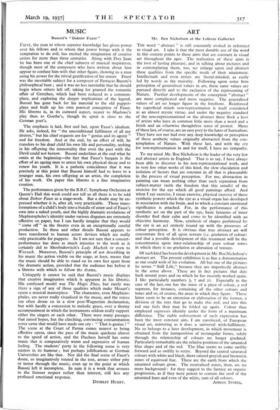Mr. Ben Nicholson at the Lefevre Galleries
ART
THE word " abstract " is still constantly evoked in reference to visual art. I take it that the most durable use of the word in this context points to those aims that are constant in visual art throughout the ages. The realisation of these duns is the root of lasting pleasure, and in talking about pictures and in contemplating them, too, we enlarge upon and abstract these qualities from the specific mode of their attainment. Intellectuals and even artists are literal-minded, as easily led by words as the majority. Following upon some firm perception of generalised values in art, these same values are pursued directly and to the exclusion of the representing of Nature. Further developments of the conception " abstract " are more complicated and more negative. The generalised values of art no longer figure in the forefront. Reinforced by superficial minds non-representation is itself considered as an almost mystic virtue, and under the negative standard of the non-representational or the abstract there flock a host of artists who have in common little more than a word and a fetish and an otherwise thoughtless sense of protest. Many of these last, of course, are an easy prey to the lures of Surrealism. They have not nor had ever any deep knowledge or perception of those aesthetic values originally abstracted from the con- templation of Nature. With these last, and with the cry for non-representation in and for itself, I have no sympathy.
To my mind Mr. Ben Nicholson is the leader of the very few real abstract artists in England. That is to say, I have always been able to discover in his non-representational work, and in- very few other works of this kind, the slow elucidation and isolation of factors that are constant in all that is pleasurable in the process of visual perception. For me, abstraction in painting can mean nothing other than such separation from subject-matter (with the freedom that this entails) of the exercise for the eye which all good paintings afford. And when I say exercise, I mean exercise, physical exercise of those synthetic powers which the eye as a visual organ has developed in association with the brain, and to which a constant emotional significance is attached. For, in the performance of this synthetic act on the part of the eye, basic fantasies of inner disorder find their calm and come to be identified with an objective harmony. Now, synthesis of shapes performed by the eye is an act entirely bound up with the processes of colour perception. It is obvious that true abstract art will concentrate first of all upon texture (i.e. gradation of colour) and that a possible development of this treatment will be the concentration upon inter-relationship of pure colour zones in which there is no gradation or alteration of texture.
Of such kind has been the development in Mr. Ben Nicholson's abstract art. The present exhibition is as fine a demonstration as one could wish of his evolution. All but one of the pictures he terms " Still Life," because they are imperfectly abstract in the sense above. These are in fact pictures that date back several years and on which he has recently worked again. I like particularly numbers 3, 7 and 21. Especially in the case of the last, one has the sense of a piece of colour, a red segment, for instance, containing all the other colours and tones and so, of course, the areas in which they figure. These latter seem to be an extension or elaboration of the former, a division of the rays that go to make this red, and into this red one feels they may be folded up again. Colour thus employed expresses identity under the form of a maximum difference. The stable enforcement of such expression has been the most constant aim, I am convinced, of European visual art, mirroring as it does a universal wish-fulfilment. No zo belongs to a later development, in which movement is obtained from the juxtaposition of rectangular forms, solely through the relationship of colours no longer gradated. Particularly remarkable are the relative positions of the saturated blue shape and of the red. The blue seems to come swiftly forward and as swiftly to retire. Beyond the central saturated colours with white and black, there extend greyish and brownish zones of equivocal hue. These are the earth from which the saturated colours grow. The neutralised zones, then, are no mere background : for they suggest to the fantasy an organic progression, as if they were potent to contain the seed of the saturated hues and even of the white, sum of all colours.
ADRIAN STOKES.




































































 Previous page
Previous page